Tag Archives: SEATTLE LANDSCAPE ARCHITECT
Creating a Beautiful and Productive Edible Landscape: Tips and Ideas – By Alice Robertson for Seattle Landscape Architect Brooks Kolb
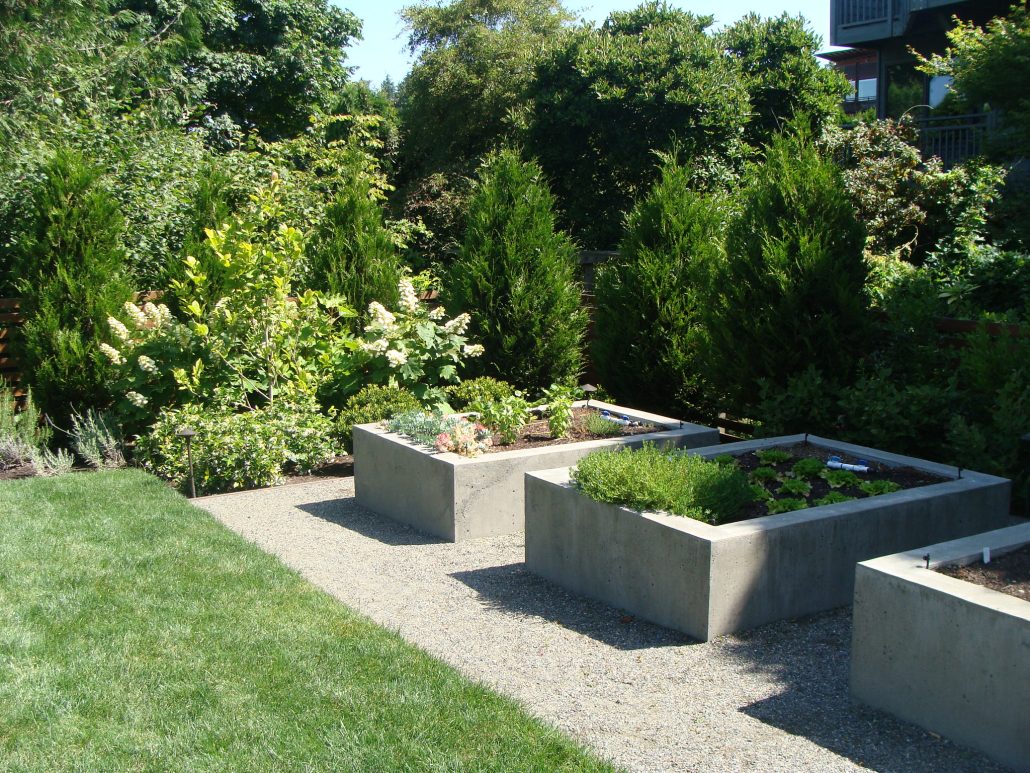
Photo by Brooks Kolb
Edible landscaping is an exciting concept that combines the aesthetic beauty of a traditional garden with the functional benefits of a home-grown food source. Imagine stepping out into your yard and plucking fresh herbs, fruits, and vegetables for your evening meal, all while enjoying a stunning visual environment. This approach to gardening allows you to make the most of your outdoor space, elevating it from merely decorative to deliciously practical. In this article by Brooks Kolb LLC, Landscape Architects, we’ll delve into various tips and ideas to help you create an edible landscape that’s both functional and visually pleasing.
Keep Colors and Flavors Exciting
When planning your edible garden, don’t overlook the power of edible flowers like nasturtiums, violets, and calendulas: Top 12 Edible Flowers and Their Various Health Benefits – Dr. Axe (draxe.com) These blooms not only provide a pop of color but can also be used in your culinary endeavors. Edible flowers can be sprinkled on salads, used to garnish desserts, or even steeped to make teas. Edible Flowers and How to Use Them (marthastewart.com) They offer an excellent way to infuse vibrant colors and subtle flavors into both your garden and your meals.
Think Vertically
Vertical gardening can significantly maximize your growing area, especially if you have limited ground space: How to Utilize Vertical Gardening For Maximizing Space (trugreenmidsouth.com) Utilize trellises, arbors, or supports for plants like beans, cucumbers, and tomatoes. These structures allow your plants to grow upwards, making efficient use of available space and adding a touch of beauty. Climbing plants on elegant structures creates an eye-catching element that’s both useful and artistic.
Got Pests? Use Companion Planting
Companion planting involves growing different types of plants together that can benefit each other in various ways, such as natural pest control: The power of companion planting | Kew For instance, basil can deter thrips and mosquitoes, making it a great companion for tomatoes. This technique not only helps you to keep harmful pests at bay but also promotes a balanced and healthy garden ecosystem.
Explore Eco-Friendly Pest Solutions
Aside from companion planting, there are other eco-friendly solutions for keeping pests out of your edible garden. Planting geraniums or African marigolds can deter Japanese beetles, reducing the need for chemical pesticides: Where Do Japanese Beetles Go at Night? – Home Garden Hero These natural alternatives are not only better for the environment but also ensure that your home-grown produce remains chemical-free and organic.
Use Mulch Weed Control and Soil Maintenance
Mulching is an essential step in creating a low-maintenance, productive garden. Organic mulches like straw, wood chips, or compost help retain soil moisture and suppress weed growth. This adds to the overall neat appearance of your garden and saves you the trouble of frequent weeding and watering.
Use Vines to Create a Natural Canopy
To achieve a garden that’s both visually stunning and bountiful, consider incorporating edible vines like grape or kiwi into your landscape design. These fast-growing vines can be expertly trained to climb over pergolas or archways, forming a lush, natural canopy that offers much-needed shade and imbues your outdoor space with a serene ambiance. The cherry on top of this charming setup is the delicious fruit these vines produce, allowing you to enjoy fresh, home-grown treats straight from the vine. This approach melds aesthetic appeal with practical utility, making your garden a feast for both the eyes and the palate.
Invite Friends to a Garden Party
One of the most enjoyable ways to appreciate your edible landscape is by sharing it with others. Invite family and friends to a garden party or an al fresco dinner featuring produce from your garden. There are numerous online platforms offering hassle-free templates for your invites, making the planning process simple and enjoyable: Free Invitation Maker with Online Templates | Adobe Express You can even upload your own photos to include in the invites (as well as add color and text) to make them superb.
Monetize Your Garden Through Education
If you’ve become a pro at edible landscaping, why not monetize your expertise? Starting a YouTube channel or even a small business offering edible garden consulting could be lucrative and fulfilling. If you decide to take the business route, forming an LLC via ZenBusiness offers benefits like limited liability, tax advantages, and more flexibility in your operations: How to Start an LLC in Washington for $0 | WA LLC Registration | ZenBusiness Inc.
Creating an edible landscape that’s both functional and beautiful is an achievable goal with a bit of planning and creativity. From incorporating edible flowers and utilizing vertical space to exploring eco-friendly pest control and even monetizing your expertise, the possibilities are endless. By implementing these tips and ideas, you can transform your outdoor area into a vibrant, productive, and visually appealing space. And if you’d rather leave this job to the pros, get in touch with Brooks Kolb LLC, Landscape Architecture today.
You can reach Alice Robertson at alice@tidyhome.info.
How to Bring Your Landscape Design to Life
By Jo Ellen Meyers Sharp for Seattle Landscape Architect Brooks Kolb

A landscape that is truly alive teems with birds, bees, butterflies, and other pollinators. You can stand by the plants and see insects and birds flit from plant to plant, chomping on seeds and slurping up nectar.
Or perhaps along with pollinators, your landscape design has sculpture and other elements that add fun, surprises, and beauty to enliven the scene.
Here are five ways to bring your landscape design to life:
1. Select Plants to Attract Pollinators

Native birds and bees are hard-wired to seek out native plants for their seeds, pollen, nectar, and as host plants.
Monarch butterflies are a good example of using plants as hosts. These butterflies lay eggs only on milkweed plants (Aesclepias spp.). As the eggs hatch, caterpillars eat the leaves of the plants. As they develop, the caterpillars form a pupa, from which emerges the monarch butterfly.
Swallowtails have an appetite for edible plants like parsley, fennel, and dill. The butterflies lay eggs on these plants. The eggs hatch and the caterpillars follow the same life development as the monarchs.
Hummingbirds visit trumpet-shaped flowers of many colors, including reds, pinks, and blues. They love the flowers of fuchsia, a favorite landscape plant in Seattle.
If you’d like your home landscape to do a better job of attracting pollinators, Seattle Landscape Architect Brooks Kolb, ASLA, would be happy to recommend bird, bee, and butterfly-friendly plant selections.
2. Add a water feature

A water source is the surest way to bring all types of wildlife to your Seattle home’s landscape. It can be something simple like a bird bath, or more complex, such as a flowing fountain or stream.
Moving water creates a pleasant sound for a calming and restful atmosphere for birds, wildlife, and you and your family. You will enjoy seeing birds swooping in to take a drink in your water feature.
3. Reduce or eliminate the use of pesticides

Avoid using pesticides to get rid of insects. Let nature take its course instead. Here’s why: Getting rid of insects in the landscape reduces food sources for birds, caterpillars, bees, and other beneficial critters.
A lot of times, just waiting a few days allows Mother Nature to step in and take care of the problem, just like a mom should.
For example, lady bugs – either the native or Asian ones – do a first-rate job of eliminating aphids. These predators usually arrive three or four days after aphids show up. Birds also like aphids. If you use an insecticide, those natural controls are lost.
If you absolutely must use a fungicide, be sure to use care when applying it. Fungicides are often deadly to bees, and some weed killers (herbicides) are toxic to insects and microorganisms. Always read and follow the label directions.
4. Have a seat

Place a bench where you can sit and watch insects and birds fly from plant to plant, or where you can hear a water feature.
Benches can be built from wood, metal, concrete, or plastic. They come in many colors and styles. Check that your bench’s material can withstand Seattle heavy rains. If opting for plastic, select heavier-grade product lines such as Polywood furniture Outdoor Patio Furniture – Made in The USA (polywood.com), which can withstand strong winds.
Instead of a bench, maybe salvage a tree stump for a seat. Or use a stump as a nature-made table in the seating area, where you can enjoy the evening garden along with a refreshing drink.
5. Express Yourself With Art
There are so many ways to add art to your Seattle home’s yard –– everything from fancy birdhouses to modern sculptures.
Art in your garden can be something you create or something you buy, and it can be as quirky or as formal as you wish. Attend a few garden tours to see what kinds of art people have in their landscapes, or visit public gardens and parks for inspiration.
Garden sculpture can be a focal point, or it can be placed so that it’s a surprise as you walk through the landscape. A stylish trellis, tuteur (vine trainer), or obelisk adds height and an artistic element to a garden bed. Installing a kinetic sculpture that moves in the wind can add a lot of drama and interest to your garden – just make sure you place it in a naturally windy spot.
Experiment with some of these ideas. If you need guidance on how to incorporate art and other natural elements to bring your landscape design consider contacting Seattle Landscape Architect, Brooks Kolb.

Jo Ellen Meyers Sharp is an award-winning garden writer, editor, and speaker. Known as a hortiholic, she frequently
says her eyes are too big for her yard. She blogs at www.hoosiergardener.com.

A Windermere Garden
Designed for art-loving clients with young children, this landscape in Seattle’s Windermere neighborhood features a broad lawn overlooking Lake Washington and the Cascade Mountains, surrounded by colorful perennial borders. After demolishing a covered swimming pool, the site was filled several feet, minimizing the number of steps down from the main floor to the garden level. A custom, linear fire feature graces a bluestone terrace outside the living room, overlooking the lawn. To the right of the fire feature, a custom children’s play area was installed over an artificial-turf safety zone. To the left, the roof of the pool equipment room was re-purposed as an outdoor dining terrace and a sculpture garden featuring three totem poles by acclaimed Seattle artist, Steve Jensen.
In the front, a new auto-court of pre-cast permeable pavers was installed, and a curving bluestone walk leads through a circular lawn to the front door. Care was taken to preserve several towering conifers and a number of large rhododendrons were moved to flank the new driveway. Low, shade-tolerant plantings border the lawn, welcoming the owners and visitors alike.
Photos by Ben Benschneider and Brooks Kolb
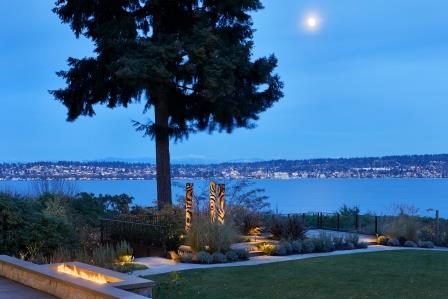
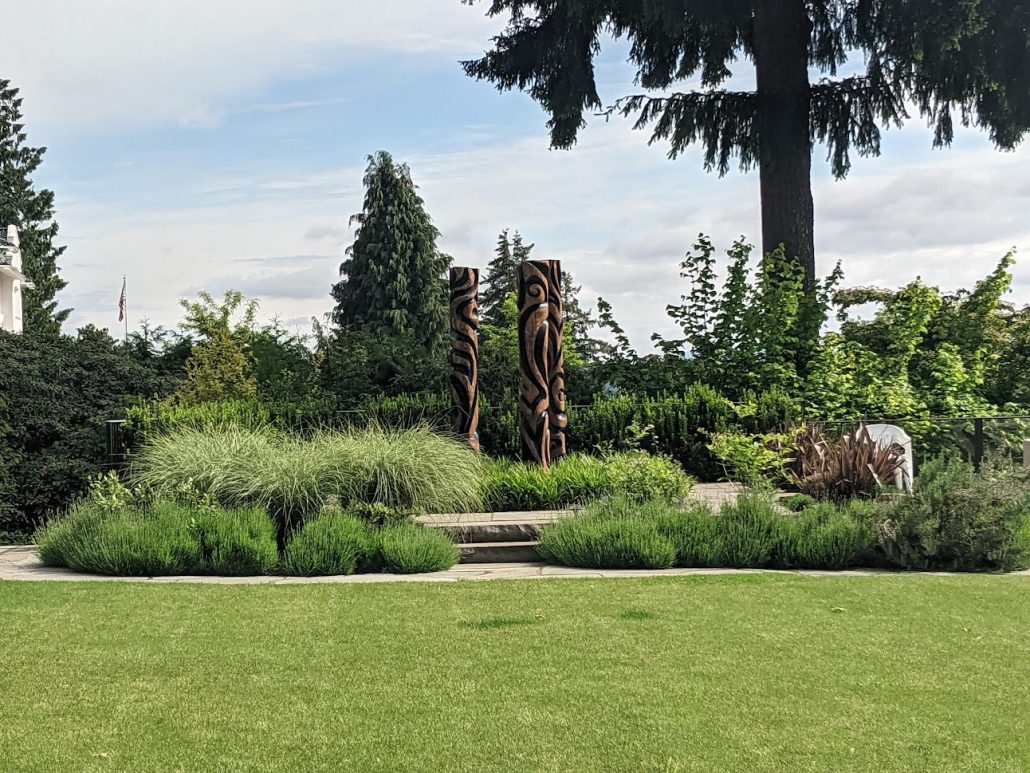
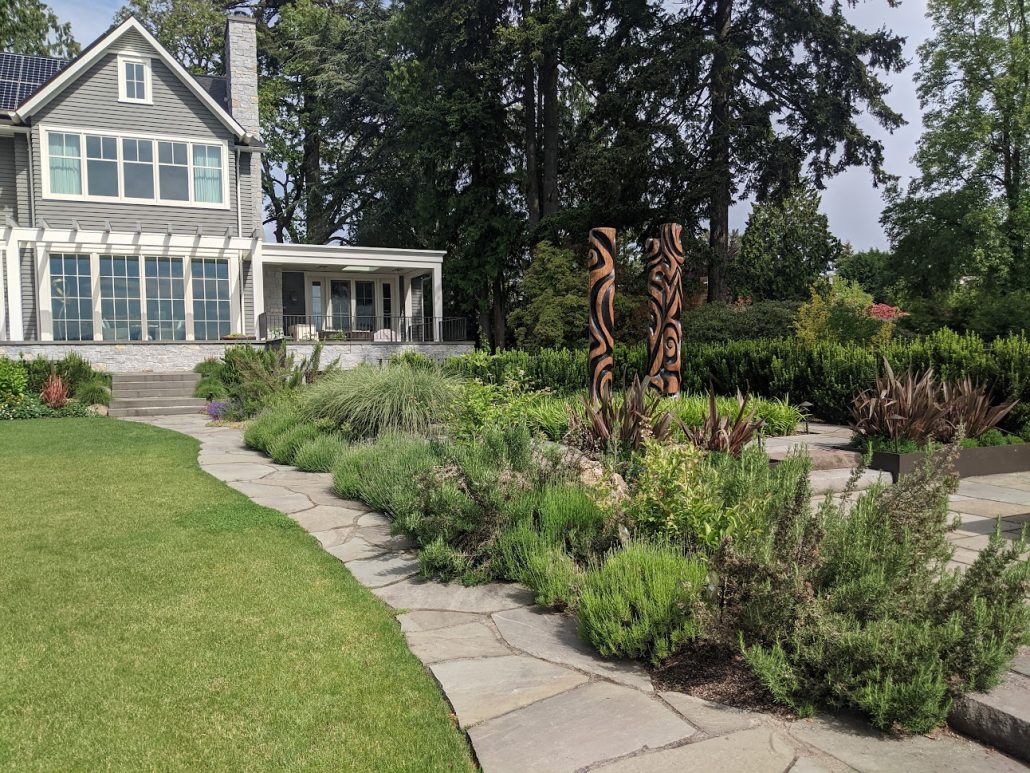
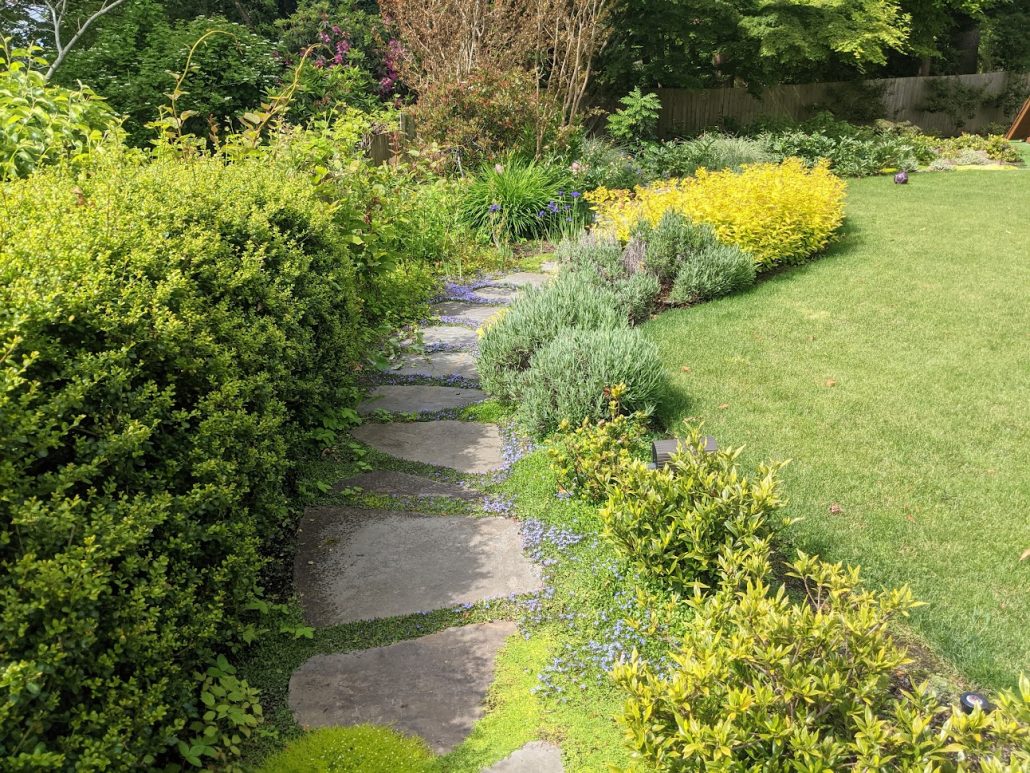
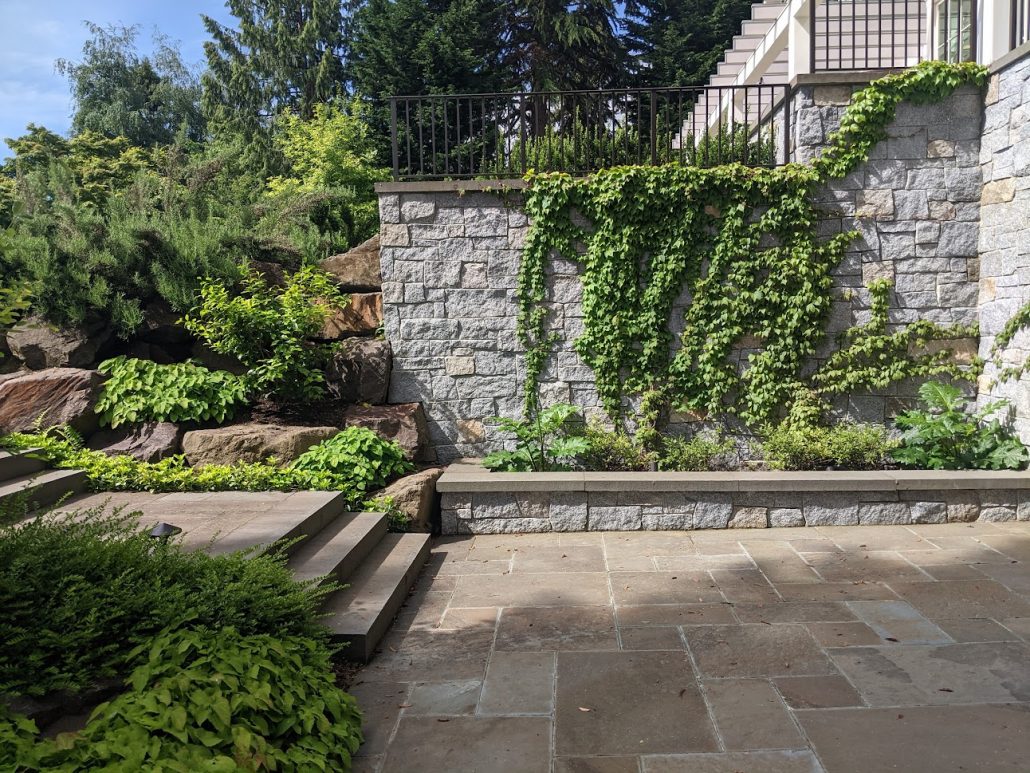
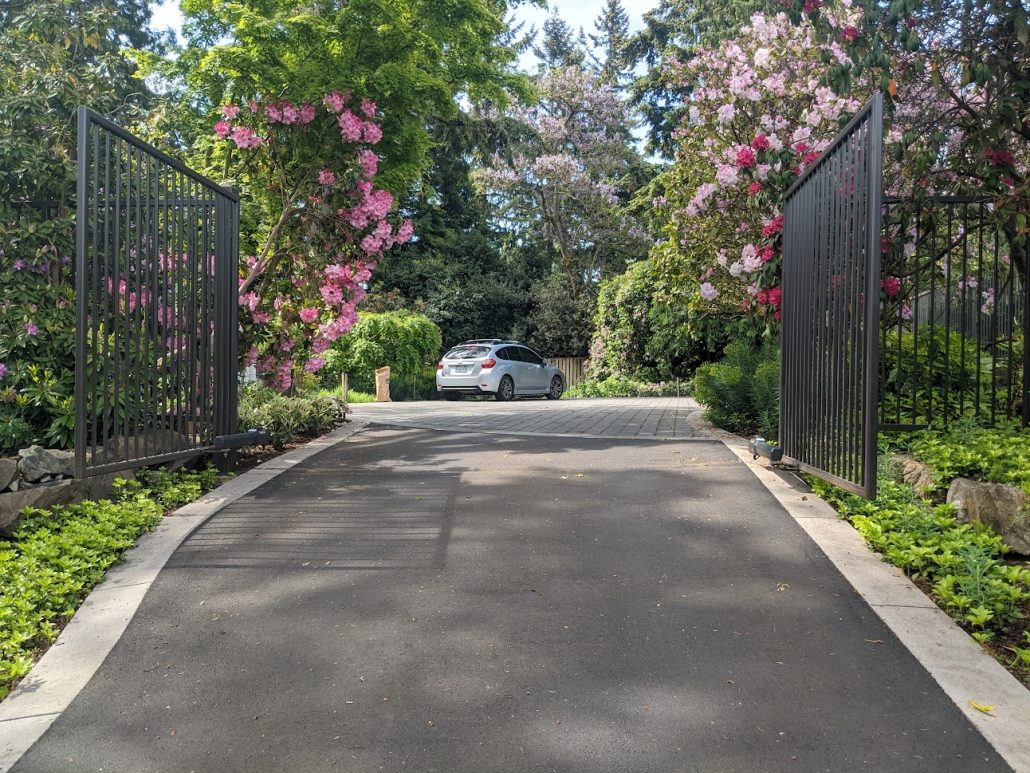
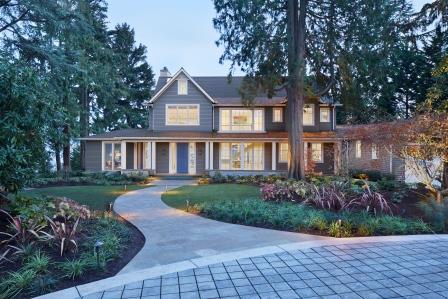
Ensure Backyard Safety With These Tips
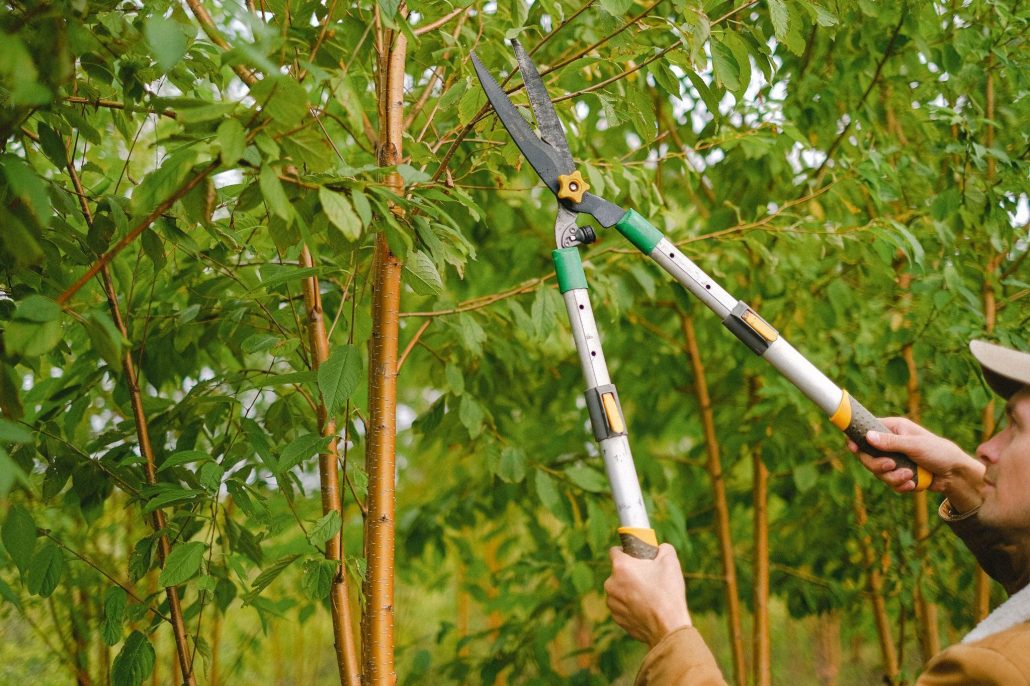
by Carrie Spencer for Seattle Landscape Architect Brooks Kolb
When warmer weather starts to arrive, many of us look forward to recreation and relaxation in our yards. Backyards, patios, and play areas all offer opportunities to connect with nature and expand our homes outdoors. When preparing for the warmer weather, Good Housekeeping Magazine notes that spring cleanup is often aimed primarily at improving our yard’s appearance, but homeowners should also consider safety as the primary goal for outdoor preparation.
Begin with an assessment and make a plan
Although people like their property to be clean, orderly, and safe, many of us don’t enjoy the hard work involved. But there are ways to make the job less arduous. A well-defined plan will allow you to work top-down in a manner that ensures the cleanup is done quickly and efficiently.
When developing the plan, assess your outdoor areas. Pay attention to possible hazards for children, such as outdoor cooking areas, fire pits, or rough hardscaped areas. Identify high-traffic zones. These are areas where you want to ensure paths are safe and secure. Patios and brick walkways can develop loose stones, which can cause accidents. Deck and patio steps are other areas that should be inspected and repaired if necessary. Once fixed, walkways, decks, patios, and exterior surfaces should be cleaned each spring.
Perhaps this is the year you’re finally able to install a fence. Not only can a fence provide additional protection for small children and pets, but it can also help boost the value of your home. When it’s time to take the plunge, look for reputable fencing companies that garner high praise from customers. Do your research so you have an idea of the materials you want to use, whether it’s wood, aluminum, or vinyl. If you’re not sure, your contractor can help you choose.
Cleaning and repairs
Wood and stone accumulate mildew, moss, and algae over colder months. This can make surfaces slick and unsafe and degrade their quality. Pressure washing is one of the best ways to clean your exterior surfaces, patios, and walkways to make them safer. The process, however, can damage surrounding flower beds and plants, so you’ll want to be careful.
Another outdoor job that you can complete is repairing window screens to prevent insects from getting into your home. Keep a look out for ponding or standing water – not only can it lead to leaks through the house foundation, but it can a breeding ground for mosquitoes, not to mention drowning your plants.
Landscape for looks and safety
After you address outdoor cleaning issues, you can focus on landscaping. Although ornamental trees and plants create beautiful visuals for your home, they also present dangers. Avoid letting trees and shrubs grow closer than two feet from exterior walls. Check any trees to see if branches are overhanging the roof or utility wires: wind-blown falling limbs can be a significant problem. Contact a certified arborist to analyze your trees and make recommendations for branch removal and any other pruning involving tall heights or power lines.
On the other hand, pruning small trees and large shrubs is an easy DIY job. When pruning, consider visibility. If your children are going to be spending a lot of time playing outside, it’s a good idea to make sure that you can see them. Trimming trees can increase this visibility. However, it’s important to practice good safety to avoid any injuries. Also, make sure you know what you’re doing when you begin pruning – there are proper pruning techniques, and you don’t want to end up with something that becomes the eyesore of your neighborhood (PlantAmnesty has some excellent pruning examples, tutorials and workshops).
The great thing about improving your landscaping and curb appeal is that it’s a win-win. Not only does it make your garden safe for kids and pets, but it can up your appraisal value as well. This makes any improvements a smart investment on both fronts. You can ascertain your property’s value increase by Googling “value my house” before and after your upgrades to see just how much.
Preparing for spring and summer requires a combination of cleaning and planning for safety. If you do this work annually and set family safety policies, you will ensure that your landscape is safe and ready for warm weather enjoyment.
Photo Credit: Pexels
Carrie Spencer can be reached at carrie@thespencersadventures.net.
Restoring a Salmon Stream
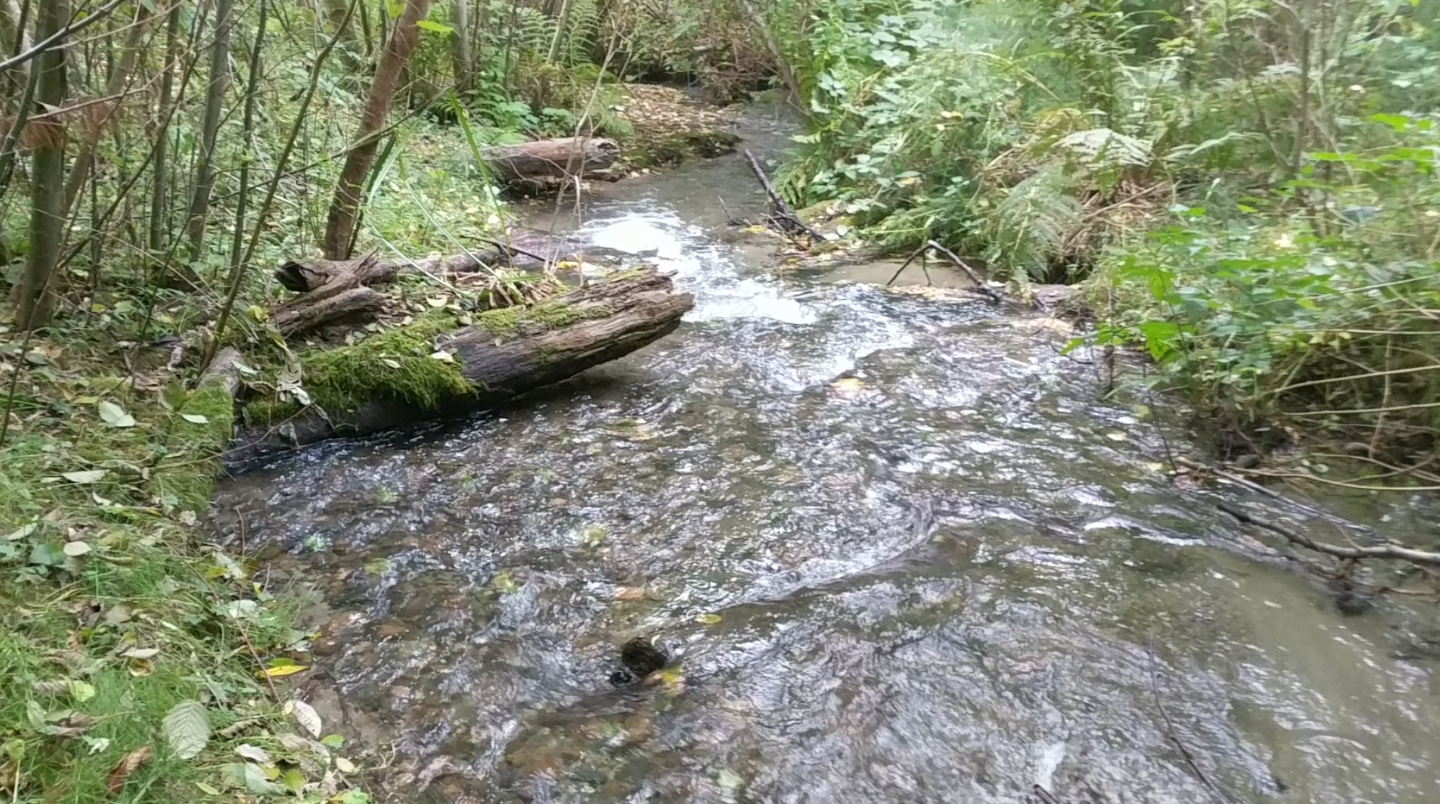
For a client with a wooded, shoreline property in the village of Holly on Hood Canal, Seattle Landscape Architect Brooks Kolb generated a landscape master plan that included restoring a salmon stream. While salmon had been entering the creek for several years on their journey to spawn, they were blocked by a culvert under a highway that had filled with sediment. After Brooks’ client convinced Kitsap County officials to remove the debris, the stream still needed to be dredged and reshaped. Brooks reached out to Tom and Kathy Smayda of Smayda Environmental Restoration (SMAYDA ENVIRONMENTAL ASSOCIATES, INC) for assistance with the hydraulic engineering and vegetation restoration. Tom, a civil engineer, personally shaped the creek with his earthmoving equipment, while wetland biologist Kathy recommended a palette of native creekside plantings. Brooks designed plantings along the creek banks and on the beach, where the goal was to anchor the sands to prevent littoral drift. Then nature took over. The stream realigned itself several times; native plants seeded themselves largely to replace the original nursery plants; and the salmon returned by the hundreds. Originally installed in 2009 and 2010, the culvert has now been cleaned out several times and in this year’s 2021 fall run, three species of salmon were spotted in the creek, including Coho and Chum.
The salmon stream in October, 2017
25,000 Daffodils for Seattle’s Volunteer Park
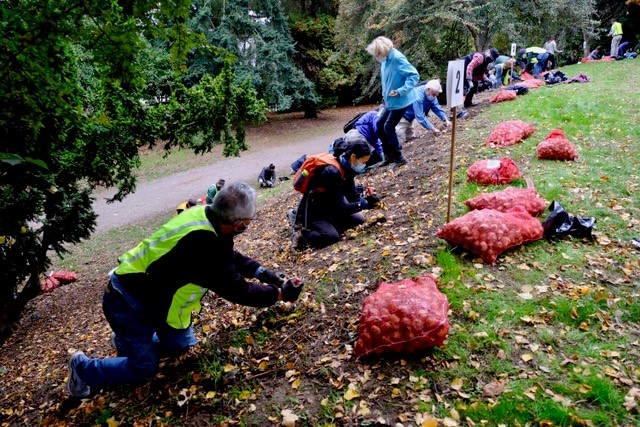
In his role as chair of the landscape committee of the Volunteer Park Trust, Seattle landscape architect Brooks Kolb recently co-led a volunteer effort to plant 25,000 daffodil bulbs on the western slopes of Volunteer Park. Installed on October 9 and October 23, 2021 in tribute to Volunteer Park Trust founding chairman, Doug Bayley, the yellow and white blooms will bring light and life next spring to a shady and under-used part of the park. Brooks picked out five varieties of daffodils at Roozengaarde Bulbs in Mount Vernon Fresh Daffodils (tulips.com) for extended bloom period and varying heights. The bulbs were planted by more than 100 volunteers at ten “stations” along the western path of the park between East Prospect Street and East Highland Drive. Each station received drifts of two contrasting varieties, drawing one’s eye gradually to the next drift along the path. The effect we were going for is a loose pattern that could be described as ‘studiedly random.’ We can’t wait to see how these hosts of yellow flowers will lift the spirits of park visitors next spring!
Many thanks to the many friends of Doug Bayley who raised funds for the daffodil purchase and to Volunteer Park head gardener Jesse Bonn. For more information about how the Volunteer Park Trust is working to preserve and enhance the jewel of Seattle’s system of Olmsted Parks and Boulevards, please visit Volunteer Park Trust – Preserving and enhancing Seattle’s Volunteer Park.
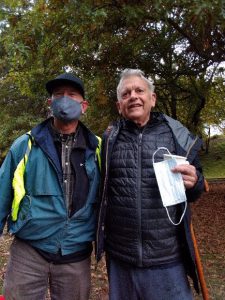
Brooks Kolb with Doug Bayley
Planting the Slopes on October 9, 2021

A Beginner’s Guide to Growing a Bountiful Garden
A Beginner’s Guide to Growing a Bountiful Garden

Photo via Pixabay
By Carrie Spencer for Seattle Landscape Architect Brooks Kolb
Want to start a garden? Planting a garden is a wonderful way to spend more time outside, enjoy some good exercise, and have access to healthful food right in your backyard. But if you’ve never grown a garden before, it can be difficult to know where to start. From choosing the right plants to keeping weeds and pests at bay, there are several tips and tricks that experienced gardeners use to ensure a bountiful harvest at the end of every growing season. Keep on reading to learn how you can earn your own green thumb!
Start with Raised Beds
As opposed to planting straight in the ground, gardening in raised beds is a lot more manageable for beginners. This is also a great way to optimize your use of garden space. According to Savvy Gardening, raised beds prevent soil compaction and provide good drainage, so your plants will be less susceptible to root suffocation and rot. Not only that, but raised beds may deter pests like slugs and snails, which can eat up your adorable sprouts before they even get a chance. Finally, raised beds offer a more ergonomic gardening option to reduce strain on your back and neck.
Know Your “Sunset” Zone
You might already have an idea of the kinds of vegetables you would like to grow in your garden, but don’t go buy seeds just yet! It’s important to be aware of our growing season in the Pacific Northwest. The U.S. Department of Agriculture (USDA) has developed a numbered system to divide the country into frost-hardiness zones based on climate, but Sunset Magazine offers a more finely-calibrated zone chart for our region. Seattle, Mercer Island, Bellevue, and the Puget Sound lowlands are in Sunset Zone 5, whereas the Cascade foothills are in Zone 4. Determine your zone and be sure to read your seed packet labels to check when it’s best to plant to ensure a good crop. Working with plants that will thrive in your climate zone will be much easier than fighting against an early frost or high summer temperatures.
Learn About Companion Planting
The easiest way to grow a garden is to let your garden take care of itself. Select plants that like to grow next to each other—they will provide a natural source of nutrients, shade, and pest-control. As The Old Farmer’s Almanac explains, three common plants to grow together are corn, pole beans, and squash. The squash provides ground cover to reduce moisture loss and weed growth, the corn provides climbing support for the beans, and the beans help make nitrogen available in the soil for the other plants. Some other great companion plant combinations include radishes and carrots, tomatoes and basil, and lettuce and garlic.
Fertilize Your Garden
Just like us, plants need food. Fertilizing your garden properly will play an important role in its success, so spend some time learning the ins and outs of fertilization. In short, you want to provide your plants with three primary elements—nitrogen, phosphorus, and potassium. Providing these nutrients will help your garden flourish! However, you also have to be careful to avoid overfertilizing your plants, which can damage or even kill them. To find out exactly how much fertilizer to feed your garden, bring a sample of your soil to a testing lab and have it analyzed before amending it with any added nutrients.
Enjoy Your Harvest!
One of the largest benefits of growing your garden is having all of that veggie goodness right at your fingertips. To make the most of your backyard bounty, find recipes that showcase the flavors of your homegrown vegetables. For your tomatoes, consider an heirloom tomato seafood platter or make your own sauce. Whip up a homemade pesto with all of that beautiful basil or use it to add flavor to your weeknight dishes. The opportunities for healthful and delicious meals are truly endless!
Gardening might seem like a lot of work, but it’s a worthwhile hobby that just keeps on giving. Once you get started, you’ll quickly find that digging around in the dirt, pulling weeds, and watering your sprouts is an incredibly therapeutic activity. You’ll always be looking for new ways to expand your backyard plot, so get outside in the fresh air and get your garden started today!
Ask for Help
If you’re feeling overwhelmed and unsure of how to get started, consider working with a professional landscape architect to help you out. Brooks Kolb LLC can guide you through the process of designing the perfect garden. All key elements will be addressed, from construction materials to the plants you want to grow.
Seattle Landscape Architect Brooks Kolb can help you create the perfect garden that seamlessly blends form and function. Contact us at (206) 324-0858 for a free initial consultation!
 Garden writer Carrie Spencer can be reached at carrie@thespencersadventures.net.
Garden writer Carrie Spencer can be reached at carrie@thespencersadventures.net.
Five Popular Outdoor Renovations That’ll Add Value to Your Seattle Area Home
By Evette Zalvino, Freelance Writer for HomeLight, for Seattle Landscape Architect Brooks Kolb
Top Agent Insights for Spring 2021: Seller’s Market Sizzles Across U.S. (homelight.com)
Renovating your backyard is a great way to prepare for a summer of entertainment, and these five renovations will add a lot of value to your Seattle home.
2020 was one heck of a year, wasn’t it? Now that 76% of Seattleites are fully vaccinated for COVID-19, it’s time to make plans to invite guests over for barbecues, parties, and a good ole’ game of volleyball (or whatever your family and friends like to play). It’s also the perfect time to give your backyard a complete overhaul and turn it into a fun and beautiful oasis that everyone will want to use and enjoy.
The question is, where do you even start; or if you’re looking to sell your home, which projects will add the most value to your home? After gathering some insights from real estate agents and landscape architects in Seattle, these landscaping renovations are what many homeowners want the most:
1. Outdoor living space
Homeowners are treating their backyards as an extension of their homes, so it shouldn’t be much of a surprise that nearly every homeowner wants an outdoor living space. This renovation isn’t just popular in Seattle, 52.5% of surveyed real estate agents from all over the country report clients say this is on their “wants” list.
These outdoor spaces can be as elaborate as you’d like, but many people opt for a simple seating terrace, with a separate dining area. It’s important to note that these spaces are not just relegated to the backyard – you can create a beautiful (but private) front garden where you can relax and enjoy a cup of coffee.
2. Lawns for playing
If you have young children (or you’re a child at heart), having a luscious lawn that’s large enough for playing outside is important for at least 50% of residential landscape clients, and can go as high as 100% for people with young children). The best types of grass for the Seattle area include Fescue and Ryegrass. These varieties are extremely resilient and, the right soils, sun exposure, watering, and regular mowing program, can withstand rigorous game-playing.
Having a large grassy area for games doesn’t mean that the rest of the landscaping must be boring or drab. You can use hardscaping to create a path that separates the lawn from garden beds filled with your favorite perennials, annuals, and shrubs.
3. Outdoor grilling setup
You may have a charcoal grill that’s seen better days, so why not plan a renovation suited for the grill master that you are? An outdoor grilling station will give you a place where you can whip up delicious barbecue while entertaining your guests – after all, who wants to be left out of all the juicy gossip or life updates?
There are a variety of options when it comes to creating the ideal grilling station that suits your needs. Many if not most people prefer to keep it simple, locating their grills on the edge of a patio, against a wall. However, you could consider erecting a pergola over your grill for rain protection, or you could install a built-in brick, wood or stone grilling station with a countertop for food preparation. There are a lot of possibilities to tailor the set-up for your particular needs.
4. Outdoor fire feature
While everyone calls them fire pits, “fire feature” is a more accurate term to describe all the various design options available to people who want to enjoy the heat and light that an outdoor fire can provide. Seattle landscape architect Brooks Kolb reports that at least 35% of his clients request a custom fire feature, while nationally 76.8% of real estate agents represent clients who either have or want fire pits. A fire feature is a great place to relax on the cooler nights while enjoying your garden or chatting with friends and family.
One affordable solution is to purchase a catalog-order fire table, which can double as an outdoor coffee table for your conversational setting, but if budget permits, custom-built fire features can incorporate masonry that matches or compliments your home’s architectural design.
5. Raised garden beds
There’s nothing like fresh herbs and vegetables to take your cooking up to a whole new level. However, bending over to tend to the plants or harvest them can be difficult for some homeowners. To remedy this or to provide an easy way to cut flowers for indoor bouquets, many people ask for raised garden beds to be a primary feature of their new landscape design. Moreover, if your garden has heavy clay soils, raised beds are almost a necessity, as they facilitate bringing in a loamy topsoil.
Whether you want to spend more time in your garden, you’re looking forward to entertain guests outdoors, or you just want to boost your property value, these landscaping renovations are a great way to start. With a little bit of imagination and planning, your landscaping is sure to be the talk of the town!
If you’d like more specific suggestions or recommendations on all these garden design features, please contact Seattle landscape architect Brooks Kolb, at 206-342-0858.
Starting a Garden on a Budget Can Be the Best Retirement Activity
By Carrie Spencer, Garden Writer,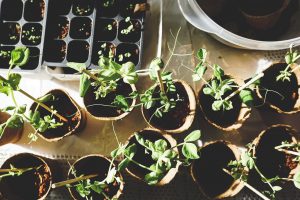 for Seattle Landscape Architect Brooks Kolb
for Seattle Landscape Architect Brooks Kolb
carrie@thespencersadventures.net
Seniors with an inordinate amount of free time after retirement are wise to spend it in productive and enriching pursuits. Undoubtedly high on the list of such worthwhile activities is gardening, as its well-known benefits are varied and plenty. Research shows that it’s a hobby that can help you live to be 100, as it offers you regular physical activity and copious amounts of outdoor time. Moreover, it’s wonderful for your mental and emotional well-being.
Your garden also has the potential to yield fresh food that can contribute to keeping your diet a healthy one. The best part is, it’s an activity that’s quite cost-effective and may even save you money in the long run. So, without further ado, let’s take a look at how you can start.
Do Your Research
No doubt, your road to a green thumb starts with due diligence since gardening has a great many nuances you’ll need to learn from the ground up (pun intended). These are largely reliant on where you are geographically speaking, what kind of garden you want to grow, and even how much time and effort you can put into it.
Luckily, there’s plenty of guidance — often for absolutely no cost — that you can find after a quick search online. For instance, if you live in a city, you may want to find out how you can grow a small garden despite space constraints, which, in turn, can give you that much-needed connection to nature. Or, if you’re looking to grow a vegetable patch, research will help you determine which vegetables are best in your area as this will ensure that you don’t waste money on the wrong seeds and time on the wrong methods.
Stock Up on Supplies
Of course, you’ll need to invest in the appropriate garden tools to help you with your initiative. This will run the gamut from trowels to shears, from gloves to wheelbarrows. It also goes without saying that you’ll need to know how each one is used in your gardening efforts.
Now, you can easily buy the gardening tools that you need, even when you’re working on a budget. Ditto with supplies like fertilizer, mulch, etc. When you’re pinching pennies, it’s definitely a great idea to buy gardening implements from retailers like Target, which often has deals on already-discounted items. You can even save more when you take the time to search online for promo codes and cashback offers that you use for additional discounts.
Starting a garden will be hard work and will require an investment, but the fact is, the return on investment you can expect can’t be beaten. At the very least, growing your own food will ultimately translate to savings toward your food budget, while you get to ward off unwanted medical bills as you eat and stay healthy. More than enough reasons to get your garden started, yes?
Are you a Seattle-area homeowner looking for sustainable garden design services? Connect with Seattle Landscape Architect Brooks Kolb! Call 206-324-0858 for a free consultation.
Photo via Pexels.com
These 3 Steps Will Help You Plant and Nurture a Productive Garden
 By Carrie Spencer, garden writer, for Seattle Landscape Architect Brooks Kolb
By Carrie Spencer, garden writer, for Seattle Landscape Architect Brooks Kolb
Growing a garden is a healthy way to enjoy the outdoors, feed your family, and support your local ecosystem. But tending to a truly productive garden requires a bit of expertise and plenty of planning. These 12 steps aim to help you nurture your garden into the best growth possible.
1. Outline a Plan Before You Begin
Dropping some seeds into dirt sounds easy. However, for the best results, plan your garden before you start digging.
- Create a sun map to understand your garden’s shade conditions.
- Draft a garden layout to follow while installing plants.
- Favor native plants whenever possible for better results.
- Select hardy companion plant combinations to attract pollinators and sustain healthy soil.
2. Adapt to the Space You Have
Know what you’re working with, whether it’s limited growing space or hundreds of acres. Here’s how to work with the space you have.
- Grow in planters for portability, convenience, and pest protection.
- Choose foods that you can grow in small spaces, including in an apartment.
- If you live in a city, start a community garden.
- Use (or build) a greenhouse for year-round production.
3. Deliver Nutrients for Optimum Growth
Your beginner garden needs lots of TLC. Of course, it also needs nutrient-rich soil, the right amount of water, and plenty of sunlight.
- Test your soil and add nutrients accordingly.
- Learn to compost and fertilize with kitchen scraps.
- Establish a healthy watering schedule for your garden.
No matter your level of expertise, you can learn to grow a garden that is as prolific as it is beautiful. With these simple steps, you can design the perfect garden for your property or apartment. Then, careful tending will bring you vegetables and flowers all season long.
Carrie Spencer created The Spencers Adventures to share her family’s homesteading adventures. On the site, she shares tips on living self-sufficiently, fruit and vegetable gardening, parenting, conservation, and more. She and her wife have 3 kids, 2 dogs, 4 cats, 3 goats, 32 chickens, and a whole bunch of bees at their home in Richmond, Virginia. Their goal to live as self-sufficiently and environmentally-consciously as possible. You can reach her at carrie@thespencersadventures.net.
Photo via Rawpixel



